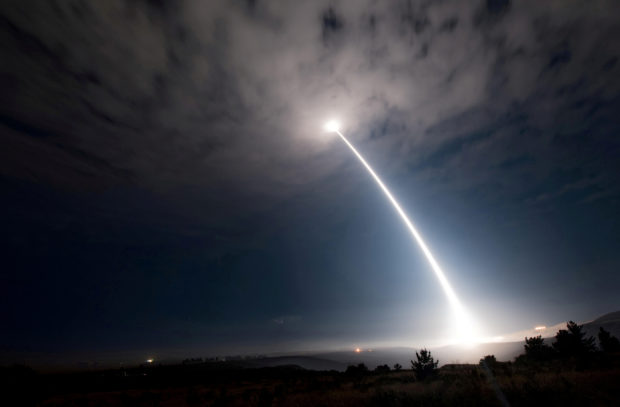US carries out missile test delayed over Chinese drills

An unarmed Minuteman III intercontinental ballistic missile launches during an operational test at 2:10 a.m. Pacific Daylight Time at Vandenberg Air Force Base, California, U.S., August 2, 2017. U.S. Air Force/Senior Airman Ian Dudley/Handout via REUTERS/File Photo
WASHINGTON — The United States military on Tuesday said it carried out a test of a Minuteman III intercontinental ballistic missile that had been delayed to avoid escalating tensions with Beijing during China’s show of force near Taiwan earlier this month.
China deployed scores of planes and fired live missiles in the Taiwan Strait after U.S. House of Representatives Speaker Nancy Pelosi made a trip to the self-ruled island. China considers Taiwan part of its territory and has never renounced using force to bring it under its control.
The test showed “the readiness of U.S. nuclear forces and provides confidence in the lethality and effectiveness of the nation’s nuclear deterrent,” a U.S. military statement said.
The re-entry vehicle traveled about 4,200 miles (6760 km) and was launched from Vandenberg Space Force Base in California.
The military said about 300 such tests have been carried out previously and that it was not the result of any specific global event.
Article continues after this advertisementThe test suggests that Washington is less worried about the situation escalating around Taiwan in the short-term at least.
Article continues after this advertisementPresident Joe Biden’s administration has said that it would continue to carry out routine air and naval operations in the Taiwan Strait in the coming weeks.
China’s military said it carried out more exercises near Taiwan on Monday as a group of U.S. lawmakers visited the Chinese-claimed island and met President Tsai Ing-wen, who said her government was committed to maintaining stability.
The U.S. military also canceled a test of its Minuteman III intercontinental ballistic missile in April. That delay had aimed to lower nuclear tensions with Russia during the ongoing war in Ukraine.
The nuclear-capable Minuteman III, made by Boeing Co., is key to the U.S. military’s strategic arsenal. The missile has a range of 6,000-plus miles (9,660-plus kms) and can travel at a speed of approximately 15,000 miles per hour (24,000 kph).
Missiles are dispersed in hardened underground silos operated by launch crews.
Russian President Vladimir Putin said in February that his nation’s nuclear forces should be put on high alert, raising fears that Russia’s invasion of Ukraine could lead to nuclear war. But U.S. officials have said they have seen no reason so far to change Washington’s nuclear alert levels.
Russia and the United States have by far the biggest arsenals of nuclear warheads after the Cold War that divided the world for much of the 20th century, pitting the West against the Soviet Union and its allies.
RELATED STORIES
Angry China stages more drills near Taiwan as US lawmakers visit
China conducts fresh drills around Taiwan as US lawmakers visit
US lawmakers arrive in Taiwan with China tensions simmering